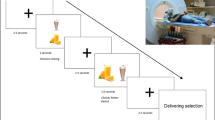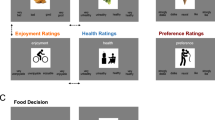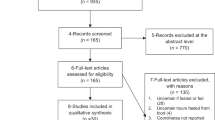Abstract
Background and aims:
The brain reward system is key to understanding adolescent obesity in the current obesogenic environment, rich in highly appetising stimuli, to which adolescents are particularly sensitive. We aimed to examine the association between body fat levels and brain reward system responsivity to general (monetary) rewards in male and female adolescents.
Methods:
Sixty-eight adolescents (34 females; mean age (s.d.)= 16.56 (1.35)) were measured for body fat levels with bioelectric impedance, and underwent a functional magnetic resonance imaging (fMRI) scan during the Monetary Incentive Delay (MID) task. The MID task reliably elicits brain activations associated with two fundamental aspects of reward processing: anticipation and feedback. We conducted regression analyses to examine the association between body fat and brain reward system responsivity during reward anticipation and feedback, while controlling for sex, age and socioeconomic status. We also analysed the moderating impact of sex on the relationship between fat levels and brain responsivity measures. Brain imaging analyses were corrected for multiple comparisons, with a cluster-defining threshold of P<0.001, and minimum cluster size of 38 contiguous voxels.
Results:
Higher body fat levels were associated with lower activation of the primary somatosensory cortex (S1) and the supramarginal gyrus during reward feedback after controlling for key sociodemographic variables. Although we did not find significant associations between body fat and brain activations during reward anticipation, S1/supramarginal gyrus activation during feedback was linked to increased negative prediction error, that is, less reward than expected, in illustrative post hoc analyses. Sex did not significantly moderate the association between body fat and brain activation in the MID task.
Conclusions:
In adolescents, higher adiposity is linked to hypo-responsivity of somatosensory regions during general (monetary) reward feedback. Findings suggest that adolescents with excess weight have blunted activation in somatosensory regions involved in reward feedback learning.
This is a preview of subscription content, access via your institution
Access options
Subscribe to this journal
Receive 12 print issues and online access
$259.00 per year
only $21.58 per issue
Buy this article
- Purchase on Springer Link
- Instant access to full article PDF
Prices may be subject to local taxes which are calculated during checkout



Similar content being viewed by others
References
Ng M, Fleming T, Robinson M, Thomson B, Graetz N, Margono C et al. Global, regional, and national prevalence of overweight and obesity in children and adults during 1980–2013: a systematic analysis for the Global Burden of Disease Study 2013. Lancet 2014; 384: 766–781.
Vandevijvere S, Chow CC, Hall KD, Umali E, Swinburn BA . Increased food energy supply as a major driver of the obesity epidemic: A global analysis. Bull World Health Organ 2015; 93: 446–456.
Swinburn BA, Sacks G, Hall KD, McPherson K, Finegood DT, Moodie ML et al. The global obesity pandemic: Shaped by global drivers and local environments. Lancet 2011; 378: 804–814.
Stice E, Figlewicz DP, Gosnell BA, Levine AS, Pratt WE . The contribution of brain reward circuits to the obesity epidemic. Neurosci Biobehav Rev 2013; 37: 2047–2058.
Stice E, Yokum S . Neural vulnerability factors that increase risk for future weight gain. Psychol Bull 2016; 142: 447–471.
Volkow N, Wang G, Baler B . Reward, dopamine and the control of food intake: Implications for obesity. Trends Cogn Sci 2011; 15: 27–46.
Knutson B, Fong GW, Adams CM, Varner JL, Hommer D . Dissociation of reward anticipation and outcome with event-related fMRI. Neuroreport 2001; 12: 3683–3687.
Knutson B, Westdorp A, Kaiser E, Hommer D . FMRI visualization of brain activity during a Monetary Incentive Delay Task. Neuroimage 2000; 12: 20–27.
Stice E, Yokum S, Burger KS, Epstein LH, Small DM . Youth at risk for obesity show greater activation of striatal and somatosensory regions to food. J Neurosci 2011; 31: 4360–4366.
Stice E, Spoor S, Bohon C, Veldhuizen MG, Small DM . Relation of reward from food intake and anticipated food intake to obesity: A functional magnetic resonance imaging study. J Abnorm Psychol 2008; 117: 924–935.
Müller MJ, Lagerpusch M, Enderle J, Schautz B, Heller M, Bosy-Westphal A . Beyond the body mass index: Tracking body composition in the pathogenesis of obesity and the metabolic syndrome. Obes Rev 2012; 13: 6–13.
Goodwin K, Syme C, Abrahamowicz M, Leonard GT, Richer L, Perron M et al. Routine clinical measures of adiposity as predictors of visceral fat in adolescence: A population-based magnetic resonance imaging study. PLoS One 2013; 8: e79896.
Loomba-Albrecht LA, Styne DM . Effect of puberty on body composition. Curr Opin Endocrinol Diabetes Obes 2009; 16: 10–15.
Rapuano KM, Huckins JF, Sargent JD, Heatherton TF, Kelley WM . Individual differences in reward and somatosensory-motor brain regions correlate with adiposity in adolescents. Cereb Cortex 2016; 26: 2602–2611.
Kringelbach ML, Stein A, van Hartevelt TJ . The functional human neuroanatomy of food pleasure cycles. Physiol Behav 2012; 106: 307–316.
Wang GJ, Volkow ND, Thanos PK, Fowler JS . Imaging of brain dopamine pathways: Implications for understanding obesity. J Addict Med 2009; 3: 8–18.
Pleger B, Ruff CC, Blankenburg F, Klöppel S, Driver J, Dolan RJ . Influence of dopaminergically mediated reward on somatosensory decision-making. PLoS Biol 2009; 7: e1000164.
van Duin EDA, Goossens L, Hernaus D, da Silva Alves F, Schmitz N, Schruers K et al. Neural correlates of reward processing in adults with 22q11 deletion syndrome. J Neurodev Disord 2016; 8: 25.
Alarcón G, Cservenka A, Nagel BJ . Adolescent neural response to reward is related to participant sex and task motivation. Brain Cogn 2016; 111: 51–62.
Cole TJ, Bellizzi MC, Flegal KM, Dietz WH . Establishing a standard definition for child overweight and obesity worldwide: International survey. BMJ 2000; 320: 7244.
Jebb SA, Cole TJ, Doman D, Murgatroyd PR, Prentice AM . Evaluation of the novel Tanita body-fat analyser to measure body composition by comparison with a four-compartment model. Br J Nutr 2000; 83: 115–122.
Vicente-Rodríguez G, Rey-López JP, Mesana MI, Poortvliet E, Ortega FB, Polito A et al. Reliability and intermethod agreement for body fat assessment among two field and two laboratory methods in adolescents. Obesity 2012; 20: 221–228.
Verdejo-Román J, Vilar-López R, Navas JF, Soriano-Mas C, Verdejo-García A . Brain reward system’s alterations in response to food and monetary stimuli in overweight and obese individuals. Hum Brain Mapp 2016; 38: 666–677.
McCarthy HD, Cole TJ, Fry T, Jebb SA, Prentice AM . Body fat reference curves for children. Int J Obes 2006; 30: 598–602.
Sescousse G, Caldú X, Segura B, Dreher JC . Processing of primary and secondary rewards: A quantitative meta-analysis and review of human functional neuroimaging studies. Neurosci Biobehav Rev 2013; 37: 681–696.
Liu X, Hairston J, Schrier M, Fan J . Common and distinct networks underlying reward valence and processing stages: A meta-analysis of functional neuroimaging studies. Neurosci Biobehav Rev 2011; 35: 1219–1236.
Maldjian JA, Laurienti PJ, Kraft RA, Burdette JH . An automated method for neuroanatomic and cytoarchitectonic atlas-based interrogation of fMRI data sets. Neuroimage 2003; 19: 1233–1239.
Song X, Dong Z, Long X, Li S, Zuo X . REST: A toolkit for resting-state functional magnetic resonance imaging data processing. PLoS One 2011; 6: e25031.
Pleger B, Blankenburg F, Ruff CC, Driver J, Dolan RJ . Reward facilitates tactile judgments and modulates hemodynamic responses in human primary somatosensory cortex. J Neurosci 2008; 28: 8161–8168.
Haggard P, de Boer L . Oral somatosensory awareness. Neurosci Biobehav Rev 2014; 47: 469–484.
Wang G-J, Volkow ND, Felder C, Fowler JS, Levy AV, Pappas NR et al. Enhanced resting activity of the oral somatosensory cortex in obese subjects. Neuroreport 2002; 13: 1151–1155.
Schultz W. Dopamine reward prediction error coding. Dialogues Clin Neurosci 2016; 18: 23–32.
Robinson TE, Berridge KC . The neural basis of drug craving: An incentive-sensitization theory of addiction. Brain Res Rev 1993; 18: 247–291.
Robinson TE, Berridge KC . The incentive sensitization theory of addiction: some current issues. Philos Trans R Soc London Biol Sci 2008; 363: 3137–3146.
Carter A, Hendrikse J, Lee N, Yücel M, Verdejo-Garcia A, Andrews Z et al. The neurobiology of ‘Food Addiction’ and its implications for obesity treatment and policy. Annu Rev Nutr 2016; 36: 105–128.
Volkow ND, Wang GJ, Fowler JS, Telang F . Overlapping neuronal circuits in addiction and obesity: Evidence of systems pathology. Philos Trans R Soc B Biol Sci 2008; 363: 3191–3200.
Shulman EP, Harden KP, Chein JM, Steinberg L . Sex differences in the developmental trajectories of impulse control and sensation-seeking from early adolescence to early adulthood. J Youth Adolesc 2015; 44: 1–17.
Cho C, Smith DV, Delgado MR . Reward sensitivity enhances ventrolateral prefrontal cortex activation during free choice. Front Neurosci 2016; 10: 529.
Verdejo-Garcia A, Clark L, Verdejo-Román J, Albein-Urios N, Martinez-Gonzalez JM, Gutierrez B et al. Neural substrates of cognitive flexibility in cocaine and gambling addictions. Br J Psychiatry 2015; 207: 158–164.
Poldrack RA, Baker CI, Durnez J, Gorgolewski KJ, Matthews PM, Mufanò MR et al. Scanning the horizon: Towards transparent and reproducible neuroimaging research. Nat Rev Neurosci 2017; 18: 115–126..
Woo CW, Krishnan A, Wager TD . Cluster-extent based thresholding in fMRI analyses: Pitfalls and recommendations. Neuroimage 2014; 91: 412–419.
Schultz W . Dopamine reward prediction error coding. Dialogues Clin Neurosci 2016; 18: 23–32.
Acknowledgements
The research described in this paper has been funded by the project grant Neuroecobe (HUM-6635) from the Andalusian Council of Innovation, Science and Industry (Andalusia, Spain) to AVG. JFN is supported by a grant from the Spanish Ministry of Education, Culture and Sport (FPU13/00669). JVR is supported by a postdoctoral fellowship linked to the Neuroecobe project grant.
Author information
Authors and Affiliations
Corresponding author
Ethics declarations
Competing interests
The authors declare no conflict of interest.
Additional information
Supplementary Information accompanies this paper on International Journal of Obesity website
Rights and permissions
About this article
Cite this article
Navas, J., Barrós-Loscertales, A., Costumero-Ramos, V. et al. Excessive body fat linked to blunted somatosensory cortex response to general reward in adolescents. Int J Obes 42, 88–94 (2018). https://doi.org/10.1038/ijo.2017.207
Received:
Revised:
Accepted:
Published:
Issue Date:
DOI: https://doi.org/10.1038/ijo.2017.207
This article is cited by
-
Lost in Translation? On the Need for Convergence in Animal and Human Studies on the Role of Dopamine in Diet-Induced Obesity
Current Addiction Reports (2019)
-
Structural changes in brain regions involved in executive-control and self-referential processing after sleeve gastrectomy in obese patients
Brain Imaging and Behavior (2019)



